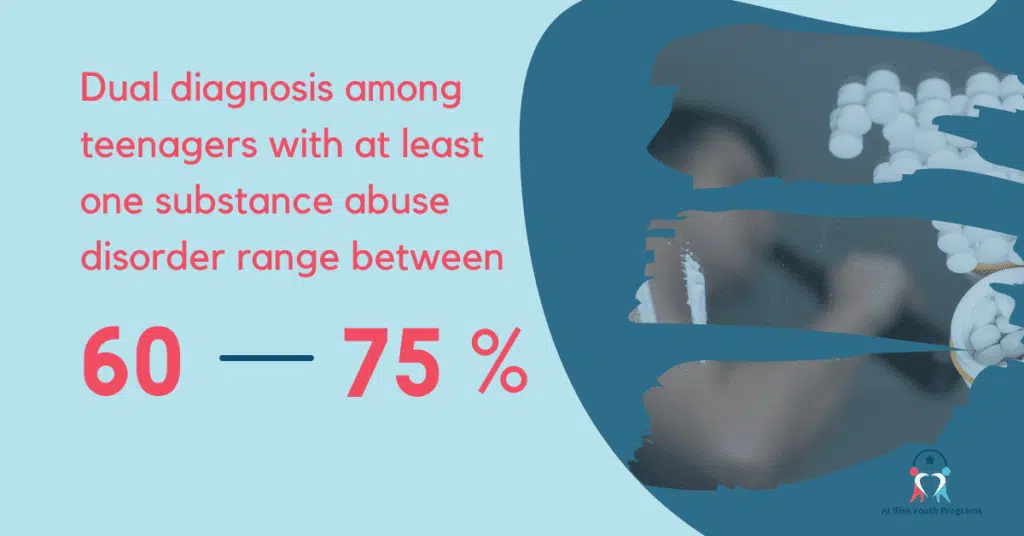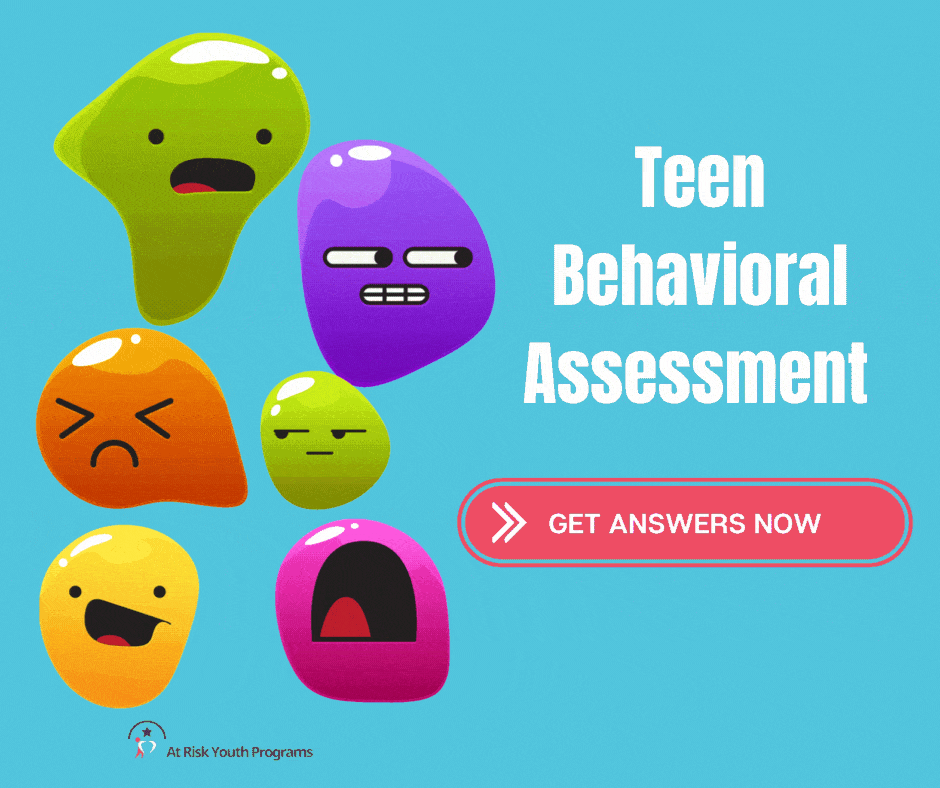Residential Treatment for At Risk Youth with Dual Diagnosis
What is Dual Diagnosis?
When a teen receives a dual diagnosis following a comprehensive mental health evaluation, that generally indicates the teen has been diagnosed with a mental illness and a substance or behavioral (eating, Internet, gambling, sex) addiction. Also referred to as a “comorbidity” a dual diagnosis typically involves common co-occurring disorders in adolescents, such as major depression and drug addiction, a personality disorder and severe anxiety, or obsessive-compulsive disorder and Internet addiction.
Although a teen can have a dual diagnosis of two or more mental illnesses without addiction, it’s more probable that doctors assigning a dual diagnosis to a teen is diagnosing the child with an addiction and a mental illness.
Mental Illness and Addiction During Adolescence
At Risk Youths often turn to alcohol or drugs to self-medicate. Personality disorders, anxiety, depression, PTSD, and ADHD are diagnosed in most teens who abuse addictive substances. In fact, rates of dual diagnosis among teenagers with at least one substance abuse disorder range between 60 to 75 percent.

Adolescents experiencing episodes of major or severe depression are twice as likely to drink alcohol or use drugs compared to teens in the same age group who do not suffer major or severe depression. Moreover, nearly 20 percent of teens who never used drugs before will begin experimenting with marijuana, prescription opioids, heroin, or other drugs after having a major depressive episode. Experimentation almost always leads to addiction and the rapid worsening of a teenager’’s mental illness.
Does a substance abuse disorder cause mental illness or does a mental illness cause a teenager to turn to substance use to escape the emotional pain of mental illness? Adolescent psychologists say that co-occurring disorders in teens can happen either way but, in most cases, an undiagnosed mental illness will make a teen more vulnerable to substance use disorders or developing a behavioral addiction.
When a Teen Dual Diagnosis Involves Two or More Mental Health Disorders
Comorbidity in adolescents does not have to include drug use, substance addiction or behavioral addiction. When a teen is diagnosed with bipolar disorder, PTSD, ADHD, or a personality disorder, they are also often co-diagnosed with depression and/or anxiety. Alternately, conduct disorder (CD) and oppositional defiant disorder (ODD) are sometimes co-morbid with paranoid personality disorder (PDD). Since teens with CD or ODD exhibit irrationally aggressive and angry behavior, the cause of this resentment could stem from paranoid thoughts.
One of the most serious mental illnesses a teen can be diagnosed with is schizophrenia. Symptoms of schizophrenia usually develop in older teens and young adults between the ages of 16 and 25. Studies reveal that individuals with schizophrenia tend to be heavy cigarette and/or pot smokers. In addition, nearly half of all teens and young adults with schizophrenia abuse drugs or alcohol, over 70 percent are addicted to nicotine.
Scientists think nicotine interacts with certain brain pathways involved in schizophrenia to alleviate symptoms of schizophrenia. In fact, nicotine may be a form of self-medication for heavy smokers with undiagnosed schizophrenia.
Residential Treatment Centers for Teens with Dual Diagnosis and Comorbidities
Inpatient treatment programs for teens with a dual diagnosis are individualized to address the specific severity of their addiction and mental illness. Most programs include a comprehensive range of services to coordinate the most effective treatment outcome. Dual diagnosis treatment protocols commonly used include:
- Medication-assisted treatment (MAT)
- Crisis intervention (crisis and distress emergency psychiatric services)
- Individual and group therapy
- Intensive psychotherapy (cognitive behavioral therapy, motivational interviewing, dialectical behavioral therapy)
In the past, adolescents with a dual diagnosis received treatment for their drug addiction first (medical detoxification, medications to reduce cravings), followed by treatment for their specific mental illness. Today, drug counselors and psychiatrists believe that it is more effective to treat both disorders simultaneously. Studies indicate that when a teen is treated for addiction and mental illness at the same time, the risk of that teen experiencing psychotic episodes and suicide attempts decreases quickly and significantly.
Inpatient mental health and substance abuse treatment centers for teens offer a structured, therapeutic environment that provides evidence-based treatment models for dual diagnosis. Teens entering residential dual diagnosis treatment centers remain at the center until they have completed their particular program.
While there, teens are provided with everything they need so they can focus solely on getting well. They also have round-the-clock access to crisis counselors, psychologists, and physicians who specialize in treating co-occurring disorders.
Concerns About Treating Teens With a Dual Diagnosis

When a parent learns their teen has been given a dual diagnosis, they often feel relieved and anxious. While it can be a relief to find out exactly what is wrong with your child, knowing how and where to find excellent treatment is stressful and confusing.
Parents should be reassured that inpatient centers providing dual diagnosis treatment programs for adolescents are carefully designed to give their children the best chance for a successful recovery. Dual diagnosis residential treatment centers are also called “integrated” treatment centers because they implement individualized treatment plans for both addiction and mental illness. In addition, dual diagnosis treatment plans are created to allow adaptability as the teen makes progress during their stay.
In addition to evidence-based therapies and MAT, treatment centers that address co-occurring disorders in teens also provide the following types of life skills counseling:
- Developing and maintaining healthy relationships with family and friends by learning how to communicate more effectively
- Accepting responsibility for their own actions by focusing on strengthening self-worth and self-identity
- Understanding the importance of academic success, establishing life goals, and becoming a productive member of society
- Knowing that addiction and mental illness are medical diseases and not “choices”
- Using coping techniques when feeling stressed, angry, or depressed
Cognitive behavioral therapy (CBT) is one of the strongest approaches to treating substance abuse disorders and mental illness in teenagers. CBT psychologists teach teens how to implement goal-directed methods of addressing anxiety, depression, distorted thought patterns, and symptoms of personality disorders.
Some of these methods include role-playing, challenging irrational beliefs, behavioral exposure, and self-monitoring. Studies also show that when teens receiving CBT are given medication for their depression and anxiety, treatment gains were higher compared to teens who did not take medication while receiving cognitive behavioral therapy.
Another common therapeutic technique used in dual diagnosis residential treatment centers for teens is called dialectical behavioral therapy (DBT). Originally created to address teens and adults with borderline personality disorder, DBT is now applicable for treating a variety of mental health problems, including anxiety disorders.
One major function of DBT targets motivating teens to want to change their behavior by showing the teen that their actions are inconsistent with creating a life they truly desire. For example, a DBT therapist gives their patients “diary cards” to keep track of behaviors that directly interfere with their quality of life.
The therapist then engages the teen in a discussion about what made them act, think or say something that disrupted their life or caused distress to themselves or others. DBT also works well in residential treatment centers that provide a structured environment for teens with dual diagnoses.
Find Out More About Co-occurring Disorders in Teens and Integrated Inpatient Treatment Programs
Call today to learn how to get immediate help for a teen with addiction and mental health issues.

What would you like to do next?
Must Read Guides and Articles

A Guide to Drug Rehab and Residential Treatment Programs for Teen Addiction
Drug Rehab and Residential Treatment Programs for Teen Addiction Residential teen rehab for drug addiction is more highly sought after now than ever. The opioid

Residential Treatment Centers for Youth Behavioral Problems
What Should Parents Know About Residential Treatment Centers for Youths? Making the decision that their child needs more than outpatient treatment for behavioral problems is

Understanding Which Adolescent Residential Treatment Center Level is Best For Your At-Risk Youth
The Best Adolescent Residential Treatment Centers for Your At Risk Youth There are four distinct levels when it comes to adolescent residential treatment centers. If















